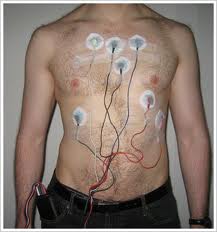Holter Monitor

In the medical field, a Holter monitor, often referred to as simply "Holter"
or occasionally as an ambulatory electrocardiography device, is a portable
apparatus designed for continuous monitoring of various electrical
activities of the cardiovascular system for a minimum of 24 hours, and
sometimes up to two weeks. While its primary use is for monitoring heart
activity, known as electrocardiography (ECG), it can also be employed for
monitoring brain activity, referred to as electroencephalography (EEG).
The extended recording duration of the Holter monitor is particularly useful
for detecting occasional cardiac arrhythmias or epileptic events that may be
difficult to identify within a shorter timeframe. For patients experiencing
more transient symptoms, a cardiac event monitor, wearable for a month or
longer, may be utilized.
Named after physicist Norman J. Holter, who invented telemetric cardiac
monitoring in 1949, the clinical use of the Holter monitor began in the
early 1960s.
When used to monitor heart activity, similar to standard
electrocardiography, the Holter monitor records electrical signals from the
heart through electrodes attached to the chest. These electrodes are
strategically positioned over bones to minimize interference from muscle
activity. The number and placement of electrodes may vary depending on the
model, but most Holter monitors use between three and eight electrodes.
These electrodes are connected to a compact device worn by the patient on a
belt or around the neck, which logs the heart's electrical activity
throughout the monitoring period.
In the past, older models utilized reel-to-reel tapes or standard audio
cassettes to record data, operating at speeds of 1.7mm or 2mm/second.
However, modern units now record onto digital flash memory devices. The
recorded data are uploaded to a computer for automatic analysis, including
counting ECG complexes, calculating summary statistics such as average,
minimum, and maximum heart rate, and identifying areas in the recording that
warrant further examination.
A Holter system typically consists of two components: the hardware, which
records the signal (referred to as the monitor or recorder), and software
for reviewing and analyzing the recorded data. Advanced Holter recorders can
display the signal, aiding in signal quality verification. Some devices
feature a "patient button" that allows patients to mark specific events,
such as feeling unwell or taking medication, for easy identification during
analysis. Additionally, modern devices may include a feature to record vocal
patient diary entries.
The size of the recorder varies depending on the manufacturer, with average
dimensions of approximately 110x70x30 mm. Most devices operate using two AA
batteries, with some allowing battery replacement during monitoring if
needed.
While most Holter monitors record ECG signals in two or three channels,
newer models feature 12-channel recording systems, utilizing the classic
Mason-Likar lead system for more comprehensive monitoring. These systems can
substitute for a stress test when it's not feasible for the patient and are
suitable for analyzing patients post-myocardial infarction. However,
recordings from these 12-lead monitors have lower resolution than standard
12-lead ECGs and may provide misleading ST segment representation in some
cases.
An interesting innovation in Holter monitors is the incorporation of a
triaxial movement sensor, which records the patient's physical activity.
This feature categorizes the patient's activity into three statuses: sleep,
standing, and walking, aiding cardiologists in analyzing recorded events in
relation to the patient's activity and diary.
undo Medical Equipment